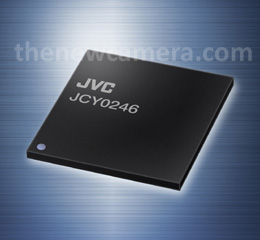 JVC has developed high-speed camera processors able to work with 8.3MP 60fps video stream. LSI enables shooting and recording Full HD, including both 2D and 3D images, and also ultra-high-resolution 4K2K images of approximately four times the resolution of Full HD. High-speed photography with high-speed processing also is possible, delivering JPEG processing at 8.3MP/60fps speed. JVC will exhibit a new consumer camcorder with the LSI at the 2011 International Consumer Electronics Show (CES), which will take place in Las Vegas, Nevada from January 6 to 9.
JVC has developed high-speed camera processors able to work with 8.3MP 60fps video stream. LSI enables shooting and recording Full HD, including both 2D and 3D images, and also ultra-high-resolution 4K2K images of approximately four times the resolution of Full HD. High-speed photography with high-speed processing also is possible, delivering JPEG processing at 8.3MP/60fps speed. JVC will exhibit a new consumer camcorder with the LSI at the 2011 International Consumer Electronics Show (CES), which will take place in Las Vegas, Nevada from January 6 to 9.
Press Release
Yokohama, Japan, December 14, 2010 - JVC announced today its development of the world’s first LSI for high-speed processing of Full High-Definition video and stills on one chip for HD camcorders.
The LSI enables shooting and recording Full HD, including both 2D and 3D images, and also ultra-high-resolution 4K2K images of approximately four times the resolution of Full HD. High-speed photography with high-speed processing also is possible. The LSI achieves low power consumption and enables lower system costs by incorporating all image-processing technologies for HD shooting, including camera-signal processing and video/still image codecs.
Consumers are increasingly demanding HD-level TVs, camcorders and other consumer electronics products, requiring manufacturers to offer products capable of rapidly processing extra-high-resolution images of the latest standards, including 4K2K. JVC’s LSI will advance this trend by introducing next-generation image-processing technologies for both professional and consumer camcorders.
JVC will exhibit a new consumer camcorder with the LSI at the 2011 International Consumer Electronics Show (CES), which will take place in Las Vegas, Nevada from January 6 to 9.
Main Features
- High-speed processing of camera signals and video/still image codecs, including Full HD 2D/3D, 4K2K and high-speed photographs. In addition to 2.7 times faster processing than previous CPU, the new CPU supports various signal-processing technologies (see below) that have been fully revised for superior high-resolution image recording;
- Signal processing
- Camera-signal processing is 1.7 times faster than JVC’s previous technology, enabling 8.3-megapixel video at 60 frames per second;
- H.264 video processing is double JVC’s previous technology, enabling compression of 2.07-megapixel images at 60 frames per second;
- JPEG still-image processing is 5.5 times faster than JVC’s previous technology, enabling compression at up to 8.3-megapixel images at 60 frames per second;
- In addition to its image-signal processor, advanced image codecs and other image-processing technologies assembled into one chip, the LSI incorporates leading-edge 40nm process technology for high functionality, 40% reduction of power consumption and 50% reduction of system costs compared to previous LSIs. The result is a high-level LSI suited to a wide range of both consumer and professional products;
- All hardware and software is integrated into one platform, enabling products that incorporate this platform to be commercialized highly rapidly.
Main Technologies
1. The LSI achieves real-time 3D compression of separate Full HD images (1920 x 1080/60p) from right and left cameras using MPEG-4 MVC. The amount of data is double the conventional side-by-side 3D recording format, enabling high-resolution Full HD 3D images with one chip.
2. 4K2K images (3840 x 2160/60p) using an ultra-resolution camera system are supported.
3. High-speed camera-processing circuitry and a high-speed JPEG engine enable the simultaneous capture of Full HD video and 8.3 megapixel stills at 60 frames per second.
4. High-speed frame video capture for 3D recording at 300 frames per second based on high-speed video codec.
History of JVC LSIs for Camcorders
JVC leveraged its years of experience with signal-processing technology to develop its first high-resolution image-processing engine, the HD Gigabrid, in spring 2007. The engine was incorporated in the Everio GZ-HD7 camcorder with internal hard disk drive, the world’s first Full HD 1920×1080i camcorder for consumers, which began selling in March 2007. Thereafter, JVC achieved higher resolutions for newer products, such as the HD Gigabrid Duo and HD Gigabrid Premium, both of which have received critical acclaim.







[…] back their 3D footage.” The JVC GS-TD1 features a pair of 3.32 megapixel CMOS sensors and a new JVC-developed high-speed imaging engine that processes the two Full HD images – left and right images at 1920 x 1080i resolution. Three […]
I am not sure where you’re getting your information, but good topic. I needs to spend some time learning more or understanding more. Thanks for excellent information I was looking for this info for my mission.
Great goods from you, man. I’ve understand your stuff previous to and you’re just extremely wonderful. I actually like what you’ve acquired here, certainly like what you are saying and the way in which you say it. You make it enjoyable and you still care for to keep it sensible. I cant wait to read far more from you. This is actually a tremendous web site.
Just desire to say your article is as astounding. The clarity in your post is just cool and i can assume you’re an expert on this subject. Fine with your permission allow me to grab your feed to keep up to date with forthcoming post. Thanks a million and please continue the rewarding work.